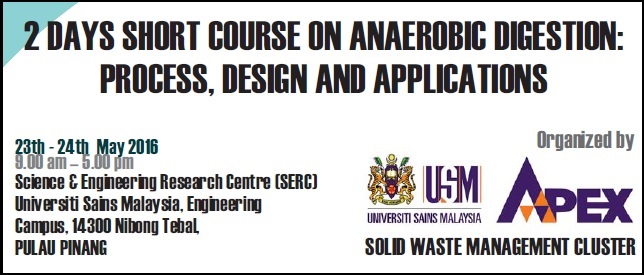Short Course on Anaerobic Digestion: Process, Design and Applications
2 Days Short Course on Anaerobic Digestion: Process, Design and Applications
Anaerobic digestion (AD) can be defined as a decomposition process of an organic matter by groups of microorganisms in an oxygen-depleted environment. This process is becoming popular nowadays because of its methane recovery potential and the nutrient-rich solids produced after digestion that can be used as a fertilizer. This method offers several potential environmental benefits including: produces biogas and useful fertilizer, reduces the organic content of the wastes, preserving the fertilizer value, eliminate biodegradable components that produces odour, reduces pathogen in the organic waste and reduces greenhouse gas emission (methane and carbon dioxide) which may lead to global warming. Typically, raw biogas comprises of 60% of methane (CH ) and another 40% of carbon dioxide (CO ), a small amount of hydrogen sulfide (H S) and ammonia (NH ). The utilization of biogas to produce heat, mechanical energy and electrical energy from AD of organic waste is not common in Malaysia. It was reported that utilization of biogas in the country was considered in early 80's and the production of biogas was conducted in a small scale. In Malaysia, the cost of electricity used in every houses and industries is still comparatively low; hence the necessity to produce power through AD is of low priority. However, due to mounting of solid wastes (especially organic wastes generated all over the country and were directly dumped into the landfills, it is possible to convert the wastes into beneficial products; as biogas, electricity, fine chemicals and also a fertilizer that can be obtained at the end of the AD process. Eventhough the energy and power produced from AD might be not enough to be supplied to the houses or industries, it still can be used as a source of electricity in a small reactor or treatment plant in Malaysia. Furthermore, the operation costs can be reduced through utilization of biogas for heat or electricity generation in the plant. This course will cover the basic theory of AD, the application of AD, design and costing of anaerobic digester, operational and troubleshooting of AD and AD experience in Malaysia.




